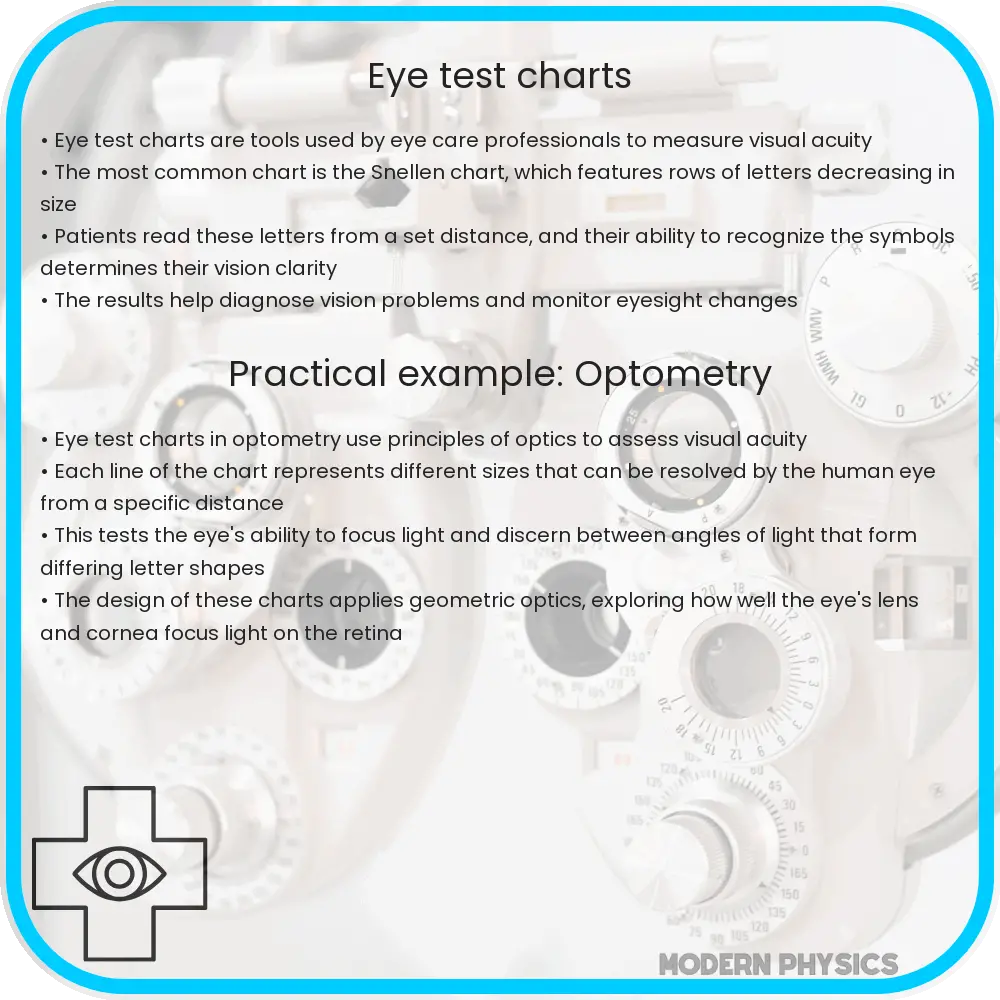Discover the essentials of eye test charts: their importance for visual clarity, accuracy in eye exams, and the role of optics in ensuring precise measurements.

Understanding Eye Test Charts
Eye test charts are essential tools in the field of optometry and ophthalmology, designed to evaluate the clarity and accuracy of a person’s vision. The most common chart, known as the Snellen chart, features rows of letters decreasing in size. This chart helps eye care professionals determine a patient’s visual acuity—the sharpness or clarity of vision at a distance of 20 feet.
The Importance of Clarity and Accuracy
Clarity and accuracy in vision testing are paramount for diagnosing and treating visual impairments. An accurate assessment ensures that individuals receive the correct prescription for glasses or contact lenses, crucial for daily activities such as reading, driving, and using digital devices. Furthermore, eye test charts can reveal signs of eye conditions like myopia (nearsightedness), hyperopia (farsightedness), astigmatism, and presbyopia, guiding further medical examination or treatment.
Optics Essentials in Eye Test Charts
The design of eye test charts incorporates essential principles of optics to assess visual function accurately. Each row on a chart is calibrated to correspond to a specific visual acuity level, measured in terms of 20/20, 20/40, etc., where the first number represents the test distance (20 feet) and the second the distance at which a person with normal vision can read the same line. This system allows eye care professionals to standardize vision assessments, ensuring consistency and reliability in diagnosing visual impairments.
Variations of Eye Test Charts
- Snellen Chart: The most recognized chart for measuring visual acuity, featuring a series of letters that decrease in size.
- LogMAR Chart: Uses a logarithmic scale to provide a more detailed assessment of visual acuity, often considered more accurate than the Snellen chart.
- Tumbling E Chart: Designed for individuals who cannot read or speak, using a series of E’s in different orientations to assess vision.
- Lea Symbols: Suitable for children and those with literacy issues, utilizing simple symbols like apples, houses, and squares.
Each type of eye test chart serves a unique purpose, catering to different age groups and specific needs, ensuring that all individuals receive a comprehensive and accurate assessment of their visual capabilities.
The Role of Eye Test Charts in Vision Health
Eye test charts are fundamental tools used by optometrists and ophthalmologists to evaluate visual acuity—the clarity or sharpness of vision. The most common example is the Snellen chart, which features rows of letters decreasing in size. Testing visual acuity is crucial for diagnosing and treating vision impairments, ensuring patients receive the correct prescription for eyeglasses or contact lenses, and assessing the health of the eyes.
Types of Eye Test Charts
Several types of eye test charts cater to different testing environments and patient needs:
- Snellen Chart: The traditional chart for measuring distance vision, often seen in eye clinics.
- LogMAR Chart: Provides a more precise measurement of visual acuity and is used for research and clinical studies.
- Tumbling E Chart: Designed for individuals who cannot read or speak, such as young children or those with certain disabilities.
- Jaeger Chart: Used to assess near vision acuity, important for reading and close-up tasks.
Accuracy and Calibration of Eye Test Charts
For eye test charts to be effective, they must be accurately calibrated and used correctly. The chart should be placed in a well-lit room at a standardized distance from the patient—typically 20 feet for the Snellen chart. The patient’s ability to read the letters or symbols provides a measure of their visual acuity, usually expressed in terms of a fraction like 20/20 or 6/6 vision, where the first number represents the testing distance and the second the distance at which a person with normal vision could read the same line.
Optical Essentials in Eye Care
Beyond visual acuity, comprehensive eye exams may include testing for color vision, depth perception, and peripheral vision. These tests help in identifying other eye conditions that might not affect clarity but are equally important for overall visual health. Moreover, advancements in optical technology have led to the development of digital eye charts and automated vision testing, offering more flexibility and accuracy in assessments.
Conclusion
Eye test charts are more than just simple tools; they are essential to diagnosing and managing vision health. Their use, alongside other diagnostic tools, ensures that visual impairments are identified and corrected early, preventing further deterioration. Regular eye exams, incorporating these charts, play a vital role in maintaining good vision and overall eye health. As technology advances, the precision and effectiveness of these tests continue to improve, offering better outcomes for patients worldwide.
